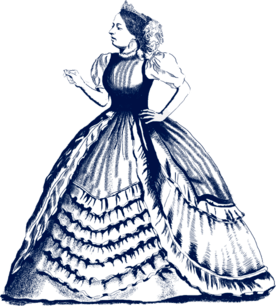Trevor I Harris reveals the fascinating true story behind one of philately’s most famous forgeries in this in-depth article from the June 2010 issue ofGibbons Stamp Monthly, the UK’s leading stamp magazine.
It has previously been thought by many that, considering their Jersey cancellations, the Lowden Forgeries were a clumsy attempt to evade Tobacco Tax. However, the truth is far more bizarre.
Britain had an insatiable need for tobacco, and the demand was from women as well as men. Indeed, smoking was considered to be perfectly acceptable at this time.
In fact, smoking was actually considered a sign of good breeding amongst the upper classes, although women would naturally only smoke using a cigarette holder.
Not wishing to miss an opportunity, applying a tax on tobacco imported from the Americas and the Caribbean at the point of entry into Great Britain was an extremely useful way for the government to raise large sums in revenue.
The islands of Jersey and Guernsey were well placed to receive these imports, and what was also convenient was the use of postage stamps as receipts for any taxation levied. As the amount of taxation paid frequently came to large sums of money, it is not surprising the most favoured stamp used as a receipt for payments was the £1 value, the highest denomination available at the time.
This being the case, it was not surprising that someone might offer a quantity of these £1 stamps with Jersey cancellations, especially since they were all on brown paper which was often used for wrapping tobacco, and their Jersey cancellations would appear to confirm that everything was in order.
The Lowden Forgery

The story now unfolds. In 1913, Mr George Lowden, a stamp dealer, contacted Mr Jonas Lex, another London stamp dealer of Holland Park Gardens, Notting Hill, London, and offered him a sack containing 2679 used copies of the Edward VII £1 stamp, all affixed to brown paper. Mr Lex agreed to buy them for 7s.9d. each stamp, and duly paid Mr Lowden the sum of £830 for the entire sack.
The stamps appeared to have watermarks, although it did later transpire that the ‘watermarks’ had been impressed on to the paper, and were not actually in the paper itself.
As the forgeries had been produced by photo-lithography, without a really close inspection they looked more or less identical to the genuine stamps, a masterpiece of forgery.
However, the general impression was not quite as sharp as that of the genuine stamps, and they had the appearance of slightly out of focus photographs, which of course is basically what they were. Apart from this, they were virtually indistinguishable from the genuine stamps.
Lowden told Mr Lex that the reason they all had Jersey cancellations was because they had been used as receipt stamps for Customs Duty charged for the importation of tobacco, and this explanation dispelled any reservations Mr Lex might have had about them.
There was at this time a shortage of used Edward VII £1 stamps on the philatelic market. Few were being used for postal purposes, although mint copies could naturally be bought from post offices.
This shortage of used stamps is reflected by the fact that dealers were selling used Edward VII £1 stamps for as much as 18s. (90p) each, almost their full face value.
It was already late in the day when Mr Lex agreed to buy the used £1 stamps, however it was only in the bright daylight of the following morning that he realised that something was not right.
They were all much paler in colour than usual, and on closer examination it was immediately evident that both the stamps and the postmarks were extremely good forgeries, good enough to deceive any casual purchaser.
Edward VII £1 stamps had been printed between 1902–10 by De La Rue, and were perforated 14 at their works in High Wycombe, with the colour in shades of blue-green.
At the end of 1910, De La Rue lost the contract for printing British stamps, the result being that provisional printings were produced, also perforated 14, by the Inland Revenue at Somerset House in London.
The colour of these provisional printings was a much darker green, often with a hint of olive. That of the forgeries was reasonably similar to the colour of the Somerset House printings, although the general impression was much coarser.
It transpired that the seller’s name was Mr John Stewart George Lowden, a stamp dealer who had been trading as George Ellis, of Villiers Street, the Strand, London. The police were called and Mr Lowden, aged 33, was arrested.
It then came to light that Mr Lowden had previously been accused of forgery when he was caught trying to sell Orange River Colony and Transvaal stamps with forged overprints some eight years earlier in 1905.
Then, in 1909, he was arrested for trying to sell forgeries of the 1888–1892 North Borneo issue, Mr Lowden somehow managed to evade conviction by persuading the prosecution that the ‘forgeries’ he was selling were not forgeries at all, as they had been printed from the original plates!
Found guilty

It eventually turned out that the £1 stamps, which had been accurately perforated 14 to a very high standard, had been produced by photo-lithography from a block of eight genuine stamps.
After a lengthy trial, Mr Lowden was predictably found guilty.
Mr Lowden was informed that a custodial sentence for his deception was inevitable, and he was sentenced to three years in prison. Very few copies of the forgeries have survived, but those which have are always found still affixed to their original paper.
It is a strange thought that examples of the forgery which are in collections today had been produced as evidence in court nearly 100 years ago!
No-one could doubt the seriousness of the crime committed by Mr Lowden. After all, he was motivated by the desire to make money by committing a fraud.
However, neither can it be ignored that the result of his dishonesty was also to bring a little extra intrigue and romance to the stamps of an already fascinating reign.
This article was first published in the Fakes, Forgeries and Experts Journal, No 13.
If you enjoyed reading this article consider a subscription to the Gibbons Stamp Monthly Archive. The GSM Archive contains every issue of the UK’s best-selling philatelic magazine - from the first issue published in July 1890 right through to the latest issue.
Browse through decades’ worth of articles, reviews, and contemporary news, or use the powerful inbuilt search function to find precisely the information you want. For an annual subscription of just £79.99, the GSM Archive gives you access to more than 40,000 pages of philatelic information, making it the perfect reference tool for collectors and philatelic researchers of all levels.
Learn more about Gibbons Stamp Monthly












